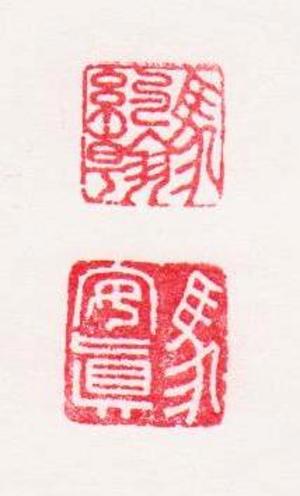CHOPS & SEALS FROM TIMES OF OLD
A “chop” (or seal) is an artifact from ancient Chinese times that surprisingly survives to this day.
After the Chinese language appeared in its written form, Chinese writing was an exclusive activity belonging to the world of scholars and well educated government officials.
Some surmise that the tradition of using stone “chops” or seals came about as a result of the predominant illiteracy of the Chinese population of old times (thousands of years ago). Of course some people (businessmen included) were illiterate and could not affix their name to the contracts written during the course of their business dealings. A stone seal was the perfect answer to this dilemma.
A seal was a kind of old-fashioned rubber stamp. It was crafted usually from a choice piece of beautiful or precious stone which bore a flat smooth edge. Upon this edge was carved the business man’s name (or family name, or a symbol) in an ancient Chinese typeface.
After a contract was drawn up and approved, the parties in agreement would dip the flat edge of their seals in bright red ink – signifying a signature written in red blood!.The seal bearers would then press the flat ink-bearing edge against the contract paper. By affixing these stone “signatures” upon the paper, the contract was as good as signed.
Another benefit that a stone seal provides is a continuously consistent image of the constituent’s signature “set in stone”. In other words, the signature rendered by the stone was difficult to forge. Usually only one stone was created per person or family, thus further reducing the chance of forgery.
SEAL SIZE
Later on, the use of a stone seal continued to spread to the point where they were used to render a signature of authority on behalf of entire businesses or formalized groups of people (such as a government entity). Because these entities or groups of people obviously carried more clout than any one individual person, usually these seals were larger in size to represent the collective power and grandeur of that entity.
As an example of relative sizes of seals, my personal stone signature seal is about 2-1/2 cm wide (see IMAGE), while the seal of the company I worked for in China was perhaps five or 6 cm wide (not shown out of professional courtesy – since to show it indiscriminately in public would be a violation of its use for business only).
Basically: the larger the seal’s image made on the page, the larger or more powerful the entity was that held that seal.
For an interesting story about how a large Chinese governmental seal was used by my former Chinese boss to enforce payment on a debt I was having trouble collecting, go to my main article page and read a piece entitled The Illustrious Madame Liu.
LONGEVITY OF LEGAL EFFECT FOR FAMILY AFFAIRS
While some seals represented the signature of an individual, it was more common to have the seal represent a larger entity, such as a family. In this case the signature carved into the stone seal bore a stylized semblance of the family name.
The advantage to going this route was so that the seal could be passed on from generation to generation. On the chance that the father closed business deal and signed a contract using the family seal, but soon thereafter died, the son (carrying on the family name borne by the seal) would be able to continue representing the contract on his father’s behalf. Proof of a son’s legally binding force could be verified because the son is able to physically hold the family seal in his hand.
Because of their power as a legal device, the security of family seals was closely held. A family’s reputation rode on such possessions, and could be ruined through the theft of the family seal. In the worst of situations, the seal could be used to sign forged documents on the family’s behalf – a kind of old-world “identity theft”.
NOT JUST CHINESE – SEALS WERE USED WORLDWIDE
Actually the use of the seal is not exclusive to Chinese culture. I speak of it here in the context of Chinese culture as a matter of convenience: as this is a culture I am most familiar with.
No doubt seals were made of different material over time and in various cultures all over the world. Seals originally appeared as images or symbols carved in stone. Nowadays they appear in the form of the more modern rubber stamps we see today, sometimes even appearing in Western business venues. For example, some accountants and barristers still use seals to “officialize” certain documents in this modern age. Notary stamps are another example of a seal, sometimes embossed in metallic foil.
THE USE OF SEALS IN POPULAR CINEMA
Two movie scenes showing the use of seals in business or government matters come to mind immediately.
The first one is the classic movie Ben Hur, starring Charlton Heston. In this movie the Arab Shiek Ilderim places a bet with Messala the Roman commander. Messala “seals” his bet with the Arab by first breathing over the metal ring on his hand to create a layer of water on the ring’s surface (so that it will not stick), and then slams his ring into the clay tablet bearing the written form of the contract they had just made.
Another movie scene showing the use of a seal (this time a Chinese seal made of stone) is in the movie The Last Emperor, starring John lone as the Emperor Puyi, and the lovely Joan Chen as Wan Jung. In this movie there is a scene when the Emperor Puyi makes an agreement with Japanese occupiers to establish a puppet Manchurian government.
To seal the written form of this agreement, this scene shows the Emperor’s gigantic seal being dipped in red ink and then placed onto the legal document, thus officially establishing the Manchurian government. If you look closely in this scene, you will see that this seal is rather large and heavy (lifted by two people), thus representing the authority associated with the Emperor as a government entity. See my comment regarding the size of seals above.
WHY CHOP? NOT CHOP SUEY
As we know, in modern times seals are now made of some kind of hard rubber – such as the kind of seals that are used to stamp your passport when you go traveling to other countries. In this context a seal is frequently called a “chop” – referring to the “chopping” sound the rubber stamp makes when the customs officer slams it down onto your passport.
The word “chop” is used frequently in Hong Kong, partly in deference to the long-time use of the English language in that part of China. In mainland China, a chop stone or similar stamp is referred to by its interchangeable names in Mandarin, tu zhang or yin zhang.
CHOP STONES AS GIFTS
I have had a look on the Internet and see that there are some services which offer to make you Chinese-style stone seals for a fair price. Some of these seals can bear both your English name and the Chinese name that the seal maker can select for you.
I write these words during the end-of-year Holiday Season. Maybe one of these seals would be a novel gift for a loved one?
In any case, I hope this has been an interesting lesson in culture.
Have fun chopping!







